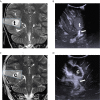Intraoperative Ultrasound-Assisted Extent of Resection Assessment in Pediatric Neurosurgical Oncology
- PMID: 33968768
- PMCID: PMC8097032
- DOI: 10.3389/fonc.2021.660805
Intraoperative Ultrasound-Assisted Extent of Resection Assessment in Pediatric Neurosurgical Oncology
Abstract
Central nervous system tumors represent the most frequent solid malignancy in the pediatric population. Maximal safe surgical resection is a mainstay of treatment, with significant prognostic impact for the majority of histotypes. Intraoperative ultrasound (ioUS) is a widely available tool in neurosurgery to assist in intracerebral disease resection. Despite technical caveats, preliminary experiences suggest a satisfactory predictive ability, when compared to magnetic resonance imaging (MRI) studies. Most of the available evidence on ioUS applications in brain tumors derive from adult series, a scenario that might not be representative of the pediatric population. We present our preliminary experience comparing ioUS-assisted resection assessment to early post-operative MRI findings in 154 consecutive brain tumor resections at our pediatric neurosurgical unit. A high concordance was observed between ioUS and post-operative MRI. Overall ioUS demonstrated a positive predictive value of 98%, a negative predictive value of 92% in assessing the presence of tumor residue compared to postoperative MRI. Overall, sensibility and specificity were 86% and 99%, respectively. On a multivariate analysis, the only variable significantly associated to unexpected tumor residue on postoperative MRI was histology. Tumor location, patient positioning during surgery, age and initial tumor volume were not significantly associated with ioUS predictive ability. Our data suggest a very good predictive value of ioUS in brain tumor resective procedures in children. Low-grade glioma, high-grade glioma and craniopharyngioma might represent a setting deserving specific endeavours in order to improve intraoperative extent of resection assessment ability.
Keywords: brain tumor; children; extent of resection; intraoperative ultrasound; neurosurgical oncology.
Copyright © 2021 Carai, De Benedictis, Calloni, Onorini, Paternò, Randi, Colafati, Mastronuzzi and Marras.
Conflict of interest statement
The authors declare that the research was conducted in the absence of any commercial or financial relationships that could be construed as a potential conflict of interest.
Figures


Similar articles
-
Efficacy of intraoperative ultrasonography in neurosurgical tumor resection.J Neurosurg Pediatr. 2018 May;21(5):504-510. doi: 10.3171/2017.11.PEDS17473. Epub 2018 Feb 16. J Neurosurg Pediatr. 2018. PMID: 29451454
-
Correlation between intraoperative ultrasound and postoperative MRI in pediatric tumor surgery.J Neurosurg Pediatr. 2016 Nov;18(5):578-584. doi: 10.3171/2016.5.PEDS15739. Epub 2016 Jul 29. J Neurosurg Pediatr. 2016. PMID: 27472668
-
Concordance of Extent of Resection Between Intraoperative Ultrasound and Postoperative MRI in Brain and Spine Tumor Resection.Cureus. 2024 Nov 20;16(11):e74101. doi: 10.7759/cureus.74101. eCollection 2024 Nov. Cureus. 2024. PMID: 39712672 Free PMC article.
-
New Hope in Brain Glioma Surgery: The Role of Intraoperative Ultrasound. A Review.Brain Sci. 2018 Nov 19;8(11):202. doi: 10.3390/brainsci8110202. Brain Sci. 2018. PMID: 30463249 Free PMC article. Review.
-
Intraoperative Ultrasound Technology in Neuro-Oncology Practice-Current Role and Future Applications.World Neurosurg. 2016 Sep;93:81-93. doi: 10.1016/j.wneu.2016.05.083. Epub 2016 Jun 4. World Neurosurg. 2016. PMID: 27268318 Review.
Cited by
-
Advances in Neuro-Oncological Imaging: An Update on Diagnostic Approach to Brain Tumors.Cancers (Basel). 2024 Jan 30;16(3):576. doi: 10.3390/cancers16030576. Cancers (Basel). 2024. PMID: 38339327 Free PMC article. Review.
-
Enhancing the Reliability of Intraoperative Ultrasound in Pediatric Space-Occupying Brain Lesions.Diagnostics (Basel). 2023 Mar 3;13(5):971. doi: 10.3390/diagnostics13050971. Diagnostics (Basel). 2023. PMID: 36900115 Free PMC article.
-
Application of intraoperative ultrasound in the resection of high-grade gliomas.Front Neurol. 2023 Oct 26;14:1240150. doi: 10.3389/fneur.2023.1240150. eCollection 2023. Front Neurol. 2023. PMID: 37965171 Free PMC article. Review.
-
Surgical treatment of pediatric low-grade glioma in developing countries.Childs Nerv Syst. 2024 Oct;40(10):3129-3134. doi: 10.1007/s00381-024-06448-y. Epub 2024 May 6. Childs Nerv Syst. 2024. PMID: 38709257 Review.
-
Second-look surgery in postoperative pediatric low-grade glioma.Childs Nerv Syst. 2024 Oct;40(10):3135-3142. doi: 10.1007/s00381-024-06516-3. Epub 2024 Jul 6. Childs Nerv Syst. 2024. PMID: 38970692 Review.
References
-
- Chacko AG, Kumar NKS, Chacko G, Athyal R, Rajshekhar V, Unsgaard G. Intraoperative ultrasound in determining the extent of resection of parenchymal brain tumours - A comparative study with computed tomography and histopathology. Acta Neurochirurgica (2003) 145:743–8. 10.1007/s00701-003-0009-2 - DOI - PubMed
LinkOut - more resources
Full Text Sources
Other Literature Sources

